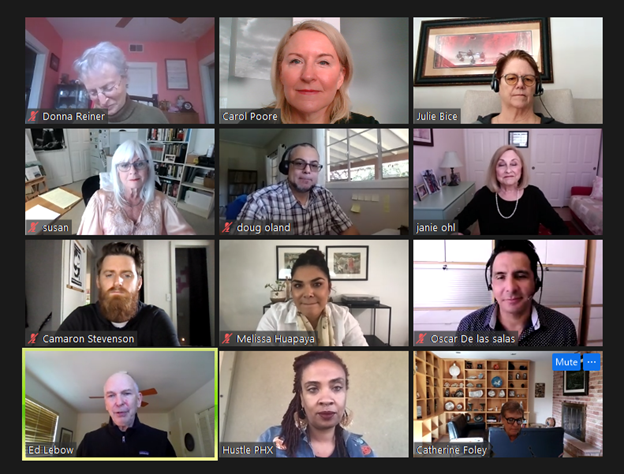I encourage you to consider how your strategic planning program might be repackaged to include virtual components, such as strategy sessions. Become skilled at weaving together webinars, video conferencing, and virtual panels, discussion forums, and breakout sessions.
Many organizations combine virtual meetings with well-structured offline activities, such as smaller group homework assignments. A series of meetings can be scheduled to bring the larger strategic planning group together where homework teams present findings, share on-screen presentations, and invite discussion.
In a virtual context where people’s attention spans are shorter while staring at others through a screen, it will require a series of virtual meetings to host what normally might occur during an in-person, one-day strategic planning meeting. For example, a virtual series could include an opening trends panel with guest speakers for the first session, followed by a fast-paced “what does this mean for us” and “what should our organization being doing to prepare for the future” type of discussion.
This could be followed by a competitive intelligence review for the second session. This could be followed by a discussion about the organization’s desired future and gap analysis for the third session, along with strategic goal breakout groups.
Suppose a trade association wants to benchmark five other state’s associations. The steering committee might identify the five top comparison states most relevant to the association.
Five homework teams could be charged with taking the assignment offline and working together in their small group. Each team could answer a list of benchmark questions about operations, financial resources, communication strategies, and member products and services. This offline investigative work would be substantial. It could include reviewing websites, placing a call to the association’s executive, and answering all questions as thoroughly as possible.
When reconvening virtually, each team could share a 20-minute presentation of the findings followed by Q&A. This session could take up to three hours, including a few stretch breaks. The session could be recorded and a written transcript including chat comments and questions could be produced. This session could be one among several to bring strategic plan participants together in an interactive virtual setting.
But the key matter at stake is how leaders will be able to create rich, meaningful leadership experiences through strategic planning without physically being in the same room together. Here are a few of my recommendations.
Focus on Creating a Vital Human Experience — Not Just the Technology Tools
Vital strategic planning focuses on creating a life-changing leadership experience starting with the workshop—a shared experience that strengthens bonds throughout the organization. If you want to build engagement and connections among your participants, you (and your organization) will need to be proficient in using the technology tools to draw people together virtually, in one room. But beyond that, you will need to be skilled at fostering relationships in distributed work environments, bringing out the best in the group.
For global and multisite companies, technology allows for frequent, cost-effective meetings. As more people work remotely, virtual strategic planning techniques can minimize barriers of distance and time, build trust, and ensure a more diverse volume of idea exchange.
One key point to keep in mind is that you will have to maintain your focus on creating a vital strategic planning experience using the three-part framework—rather than on the technology tools themselves.
This can be tricky, because proficiency with the tools is critical to conducting a smooth, seamless meeting. But the tools can’t run the meeting for you. Only you and your attention to cultivating quality conversations can make a successful meeting happen.
Focus on discussion and decision-making during your virtual meeting. Ask for input for needed decisions, and encourage use of the chat function for asking questions about the decision and voting for a decision. For smaller groups (such as fifty people or less), some organizations provide prefabricated small signs, such as “thumbs up” for quickly providing feedback like agreement and approval or a question mark if there’s confusion, and a company logo in a star for symbolizing celebration.
Having said that, new virtual meeting tools can be extremely helpful!
For virtual strategic planning, there are online voting and polling apps that resemble in-person sticky dot exercises. For example, GroupMind is a collective intelligence software for virtual idea generation, voting, and discussion. PollUnit uses round virtual dots for online opinion sharing.
In Chapter 4 of my book, Strategic Impact, I discuss a group of innovative virtual strategic planning tools, admitting that my list will quickly become outdated as new tools continue to be introduced.
Incorporate Virtual Expert Speakers and Panelists
Virtual participation, for all of its potential challenges, offers an easy solution for limited speaker and travel budgets.
I’ve included board members via Zoom who otherwise would not have been able attend a strategic planning meeting. I’ve also featured an impressive array of high-profile speakers who normally would be able to join an in-person strategic planning workshop. Another way to add life and vitality to a virtual workshop is to host a panel. I recommend no more than four, maybe five speakers—as you would do for an in-person panel—to allow ample time for each speaker to share ideas.
The key to facilitating an effective in-person panel is preparation – that is, pre-panel communication!
I recommend sending individual invitations—an e-mail followed by a letter invitation if a formal invitation is needed—asking your desired panelists to participate. You’ll want to state the purpose of the panel and a few potential topics and questions that you would be interested in having discussed.
Stay tuned for more articles about Vital VIRTUAL Strategic Planning!




